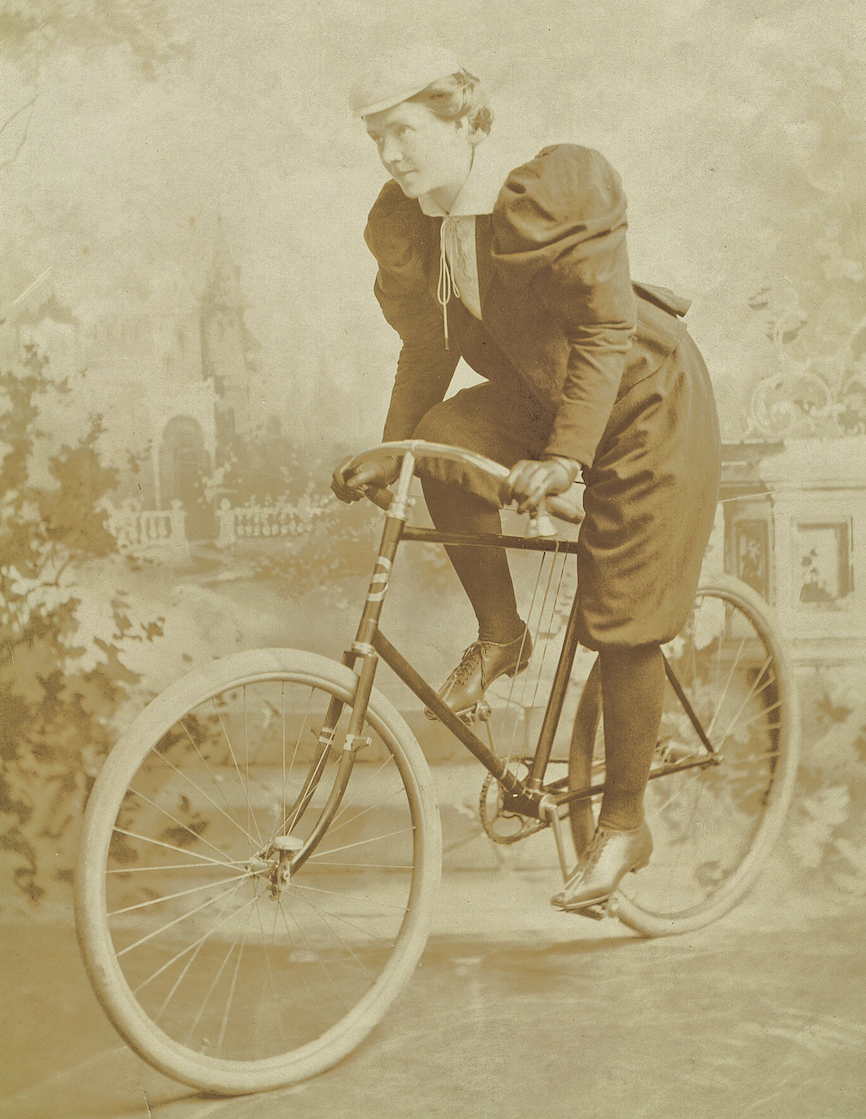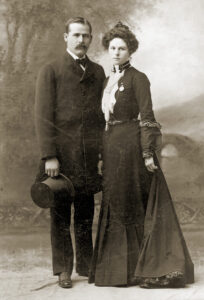It may seem improbable today that bloomers stoked the struggle for equal rights, but for women in California the trouser-like garment was worth the fight. Ladies who ventured West during the California Gold Rush soon discovered their fashionable clothing just would not do.
Corsets cinched tight enough to displace a wearer’s organs. Petticoats were magnets for knee-high mud on rainy days. Ten-pound skirts dragged in the dirt. Dresses were altogether impractical. High-heeled boots posed a risk of injury on horse-rutted streets. The entire ensemble impeded a woman’s ability to move freely when working, walking and engaging in other everyday activities.
In 1851 uncomfortable Western women received unexpected support from New Yorker Amelia Bloomer, editor of the women’s newspaper The Lily, which published several articles about the “Turkish dress”—a new ladies’ garment comprising a skirt cropped at the knees over a billowy pair of trouser-like leggings. Elizabeth Cady Stanton, a leading early suffragette, said she felt “like a captive set free from his ball and chain” when she wore bloomers.
News of the liberating costume soon reached the Golden State. “Several very respectable ladies have ‘put on the apparel,’” the Daily Alta California reported on Sept. 12, 1851, “and when the rains commence, we may of course expect very large accessions to the Bloomer ranks.”
Eastern advocates soon feared the garment detracted from more serious women’s suffrage efforts and stopped wearing it. But Western women, often out of necessity, were far more willing to defy convention and wear bloomers.
“The men wish to regulate the women,” the Daily Alta editorialized in one 1874 article, “and the women suggest reforms for the men.” The writer described a group of people who had gathered at a San Francisco convention to discuss dry goods reform but instead discussed dress reform.
A local newspaper had criticized one of the dry goods workers for wearing short skirts. “Anyone who attempts to pull down the character of another is worse than the party attacked,” the woman shot back, adding she favored reform and “care nothing for the opinion of newspapers or any other man.”
UPHILL BATTLE FOR BLOOMERS
The fight for dress reform remained an uphill battle—quite literally in San Francisco. For a decade Mrs. S.C. Smith, whose husband was too ill to work, provided for her family by working as a political canvasser. Each day she strode up and down the city’s notoriously steep streets in trailing skirts, the heavy drapes flapping incessantly on windy days. It exhausted her.
She dreamed of dress reform but was tired of waiting for someone else to take the lead. So, in November 1892 she left her home at 112 Grove Street wearing a short, loose-fitting princess dress over lady’s riding trousers. The San Francisco Call published a photo of Smith in her “reform suit” with an article headlined “Away With Skirts.”
“The comfort I have got out of it,” the wearer avowed, “has more than repaid for the few adverse criticisms I have received from the street urchins.”
Far from proving a distraction, the insistence on freedom of dress by Smith and others helped fuel the battle for women’s rights. In 1894 the North American Review published Irish feminist Sarah Grand’s article questioning the prevailing “home-is-the-woman’s-sphere” tradition and coined the term “New Woman.” In California such New Women defied convention, not only in the workplace, but also in their mode of dress and leisure activities. They bicycled, smoked and continued to wear garments that allowed greater freedom of movement.
Better FOR BICYCLES
Louise Cranston took to riding a bicycle about town, and for comfort and safety she ordered a suit of bloomers. Husband Tom, as reported in the Jan. 19, 1895, Pacific Rural Press, objected to Louise looking like “a lithograph for a variety entertainment” and incurring the jeers of passersby. “You shan’t wear bloomers,” he declared, storming out the door to work. Undaunted, Louise conspired with her bicycle-riding, bloomer-wearing neighbor Mrs. Kynaston on a plan to change Tom’s mind.
Tom returned home that evening to the sight of five bicycle-riding women—four in sporty bloomers, and the fifth, Louise, in cumbersome skirts. But he remained too proud to bend. “Don’t speak to me about bloomers again,” he told her at dinner. “You may go in for women’s rights if you like, and you may wear standing collars and men’s waistcoats, but you shall not wear trousers, even if bicycling does justify it.” The next morning Louise vowed not to ever mention bloomers. “That’s a dear, good girl,” Tom replied, vowing to do anything else she asked.
That evening Louise sprung the trap. “I want you to redeem your promise,” she told Tom, asking him to don her unfinished bicycle dress while she pinned the fabric in place. Reluctant to break his promise, he agreed. Louise soon had him firmly pinned.
At that moment Mr. Kynaston walked through the door. “Why, Tom,” said the expected neighbor in open-mouthed bemusement, “are you going to dinner?” Mortified, Tom said he would if Louise ever finished “this miserable skirt.” Noting that he and Tom were already late for their engagement, Kynaston blurted, “Oh, nonsense, why doesn’t she wear bloomers?” The ploy had worked. “If you’ll call my promise off,” Tom told Louise, “you may have bloomers or anything else you want.”

That spring Oakland residents Mrs. George A. Faulkner and Miss C. Virginia Wilson took an eight-day, 100-mile bicycle trek from San Rafael north to Ukiah. The San Francisco Call reported that the “intrepid and handsome lady cyclists” rode unescorted across terrain that “would have daunted one of the sterner sex.” Both wore bloomers. Faulkner’s ensemble was “enhanced by a small but handsomely mounted revolver. “What matter if we did meet tramps?” she posited. “I had my revolver.”
That same year, according to the Marin County Tocsin, San Francisco authorities arrested two young women for wearing masculine attire. The taller of the pair pleaded her case in court, asserting the law should not be allowed to decide what defines women’s clothing. The judge disagreed.
DRIVING WOMEN BACK TO FLOUNCES
Wearing baggy bloomers was one thing, he argued, but if the trouser-like garment were too scant, it would shatter the “witching mystery about the form divine.” Claiming it the duty of the law to “drive woman back to flowing skirts and flounces and general fluffiness,” he dismissed the pair with a stern lecture.
In 1896 the Rev. Anna Shaw, a Methodist minister and leading suffragette, gave a Bay area lecture on the New Woman. As reported in the Call, Shaw expressed support for those who chose to wear bloomers, adding, “They are more useful and far more handsome than a stovepipe hat.”
San Franciscan Annie Kirk certainly thought so. In 1897 she rode a bicycle to her dental appointment with Dr. W.A. Atwood, but he refused to treat her aching tooth because she wore bloomers. According to the Call, Kirk claimed the dentist dressed her down “in spiteful, contemptuous and insulting manner.”
She not only left indignant but also sued him for $250. Dr. Atwood claimed that such a costume would have caused his clients to flee his office. The paper didn’t follow up, but Annie’s great-grandson Kirk C. Smith said she lost her suit.
Bloomers went out of vogue, but New Women carried on the fight to wear clothing suitable to their expanding roles in and outside the home. Their humor and determination forever link the trouser-like garment to the struggle for equal rights.





